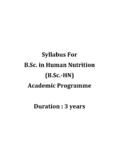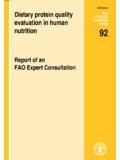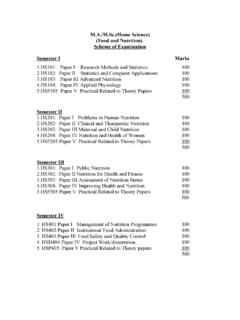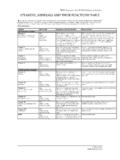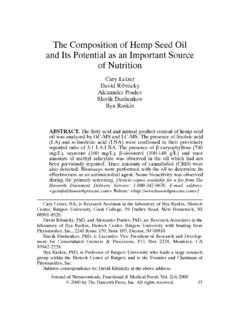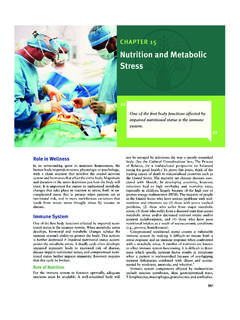Transcription of Fats and fatty acid in human nutrition - Home | Food and ...
1 Food and Agriculture Organization of the United Nations 91 Fats and fatty acids in human nutrition Report of an expert consultation FAOFats and fatty acids in human nutritionReport of an expert consultationFAOFOOD ANDNUTRITIONPAPER91 ISSN 0254-4725 Knowledge of the role of fatty acids in determining health and nutritional well-being has expanded dramatically in the past 15 years. In November 2008, an international consultation of experts was convened to consider recent scientific developments, particularly with respect to the role of fatty acids in neonatal and infant growth and development, health maintenance, the prevention of cardiovascular disease, diabetes, cancers and age-related functional decline. This report will be a useful reference for nutrition scientists, medical researchers, designers of public health interventions and food producers. 9 7 8 9 2 5 1 0 6 7 3 3 8 I1953E/1 978-92-5-106733-8 ISSN 0254-4725 91 Fats and fatty acids in human nutritionReport of an expert consultationFAOFOOD ANDNUTRITIONPAPERFOOD AND AGRICULTURE ORGANIZATION OF THE UNITED NATIONSRome, 201010 14 November 2008 GenevaThe designations employed and the presentation of material in this information product do not imply the expression of any opinion whatsoever on the part of the Food and Agriculture Organization of the United Nations (FAO) concerning the legal or development status of any country, territory, city or area or of its authorities, or concerning the delimitation of its frontiers or boundaries.
2 The mention of specific companies or products of manufacturers, whether or not these have been patented, does not imply that these have been endorsed or recommended by FAO in preference to others of a similar nature that are not 978-92-5-106733-8 All rights reserved. FAO encourages reproduction and dissemination of material in this information product. Non-commercial uses will be authorized free of charge, upon request. Reproduction for resale or other commercial purposes, including educational purposes, may incur fees. Applications for permission to reproduce or disseminate FAO copyright materials, and all other queries concerning rights and licences, should be addressed by e-mail to or to the Chief, Publishing Policy and Support Branch, Office of Knowledge Exchange, Research and Extension, FAO, Viale delle Terme di Caracalla, 00153 Rome, Italy. FAO 2010In memoriamProfessor John C. Waterlow died peacefully on 19 October 2010 at the age of 94 at the Chelsea and Westminster Hospital in London.
3 Over the last years his body had weakened but his mind was as sharp as ever up to his last days. With his passing away, the international nutrition community has lost an exceptional nutritionist. FAO will miss this remarkable, knowledgeable, reliable and loyal friend who put all his expertise and wisdom to the service of the hungry and malnourished in different parts of the world. Professor Waterlow spent approximately twenty years in the Caribbean region, working in Guyana, Trinidad and Tobago and Jamaica, where he established the Tropical Metabolism Research Unit at the University of the West Indies in Kingston, Jamaica and carried out his cutting-edge work on the pathophysiology and treatment of malnutrition. A trademark of his work was to transform complex scientific and technical issues into simple, practical messages such as his 10 easy-to-remember steps treatment guidelines for hospital staff in treating malnutrition and its related Professor Waterlow returned to the UK and began his long tenure as Professor of human nutrition at the London School of Hygiene and Tropical Medicine (LSHTM), a long-standing and strong relationship continued with FAO.
4 Because of his eclectic interests and knowledge, John s contributions ranged from childhood growth and diseases to nutrition requirements, with particular attention to protein, his specialty. He generously gave his time, expertise and prestige to support FAO and WHO in their nutrition programmes from the early 1970 s until 2004, chairing a number of expert committees and consultations and participating in numerous seminars and meetings. Even with his retirement from the LSHTM in 1981 he continued to serve selflessly. Not only did he serve, but the plethora of students he taught, in the United Kingdom and in Jamaica, served with him and then in his place after he did truly retire. He was seen by many, even those who had never studied formally under him, as the professor . Once in retirement he was reluctant to fill the place of an active scientist in scientific deliberations, noting that he was no longer current with the scientific literature.
5 However, once the deliberations began no one could quite identify those scientific areas in which he was failing. Perhaps his last scientific tour de force was the 2006 revision of the 1978 classic Protein turnover in mammalian tissues and in the whole body, which he did the old fashioned way relying on index cards and little on computer searches. John Waterlow was never interested in pushing his own research or areas of interest except when it was for the welfare of the children in the developing world or, in fact, children everywhere. When the discussion became too esoteric and argumentative, he would remind all, in an even voice and with carefully chosen words, what was the main reason they were discussing these issues and those who were the object of the discussion should not be forgotten. He will be remembered by all of us who had the benefit to work with him, for his extensive knowledge of nutrition , for his dedication for the cause of combating hunger and malnutrition in all its forms, and for his integrity and wisdom during the nutrition deliberations in international and symbolsxvCHAPTER 1: INTRODUCTION1 Scientific Developments1 Expert consultation process3 References4 CHAPTER 2.
6 SUMMARY OF CONCLUSIONS AND DIETARY RECOMMENDATIONS ON TOTAL FAT AND fatty ACIDS9 Definitions9 Levels and strength of evidence10 Summary of total fat and fatty acid requirements for adults, infants (0-24 months) and children (2-18 years)10 Conclusions and recommendations for total fat13 Conclusions and recommendations for saturated fatty acids (SFA)14 Conclusions and recommendations for monounsaturated fatty acids (MUFA)15 Conclusions and recommendations for polyunsaturated fatty acids (PUFA)15 Conclusions and recommendations for n-3 polyunsaturated fatty acid intake16 Conclusions and recommendations for n-6 polyunsaturated fatty acids 16 Conclusions and recommendations for n-6 to n-3 ratio17 Conclusions and recommendations for trans- fatty acid intake (TFA)17 Considerations for food-based dietary guidelines17 Recommendations for further research18 Recommendations on dietary information and programme needs19 Recommendations for nomenclature19 References19 CHAPTER 3: FAT AND fatty acid TERMINOLOGY, METHODS OFANALYSIS AND FAT DIGESTION AND METABOLISM21 Definition and classification of lipids21 fatty acid nomenclature21 Dietary fats and fatty acids22 Saturated fatty acids23 Unsaturated fatty acids23 Monounsaturated fatty acids23 Polyunsaturated fatty acids24 Analytical methods 25 Lipidomics26 Fat digestion, absorption and transport27 Metabolism of fatty acids28 References36viCHAPTER 4.
7 CHOICE OF DRI, CRITERIA AND TYPES OF EVIDENCE43 Choice of DRI43 Overview of prior criteria and types of evidence 46 Choice of criteria47 Chronic disease outcomes47 Physiological measures48 Deficiency symptoms and disease49 Average intakes in national survey studies49 Equilibrium maintenance50 Animal models 50 Choosing the type of evidence 50 References53 CHAPTER 5: FAT AND fatty acid REQUIREMENTS FOR ADULTS55 Fat and fatty acid requirements for adults55 Dietary recommendations for total fat intake55 Dietary recommendations for saturated fatty acids (SFA)55 Conclusions and recommended dietary requirements for MUFA57 Conclusions and recommended dietary requirements for PUFA58 Conclusions and recommended dietary requirements for n-6 polyunsaturated fatty acids 58 Conclusions and recommended dietary requirements for n-3 polyunsaturated fatty acid intake59 Conclusions and recommended dietary requirements for n-6 to n-3 ratio59 Conclusions and recommended dietary requirements for trans- fatty acid intake 60 Considerations for food-based dietary guidelines60 References60 CHAPTER 6.
8 FAT AND fatty acid REQUIREMENTS AND RECOMMENDA-TIONS FOR INFANTS OF 0-2 YEARS AND CHILDREN OF 2-18 YEARS63 Background on the role of fats and fatty acids in infant and child nutrition63 Background on essential fatty acid deficiency64 Background on energy supply from fat and early growth65 Recommendations for total fat intake of infants 0-24 months67 Recommendations for fatty acid intake of infants 0-24 months67 Comparison with the 1994 recommendations and the proposed values67 Recommendations for total fat intake for children 2-18 years69 Recommendations for fatty acid intake for children 2-18 years 69 human milk as a model to define acceptable intakes (AI) for fats and fatty acids in early life for normal infants (0 to 2 years)69 Recommendations for dietary intakes of specific essential fatty acids for infants and children70 Recommendations for dietary intakes of special groups of infants and children 70 Preterm infants70 Safety issues when considering food sources of fats intended for use by children71 Storage, packaging and distribution71 Research needs for children 2-18 years72 References72viiCHAPTER 7: FAT AND fatty acid DURING PREGNANCY AND LACTATION77 Dietary fat intake during pregnancy and lactation77 References85 CHAPTER 8: FAT AND fatty acid INTAKE AND INFLAMMATORY AND IMMUNE RESPONSE91 Immunity91 Innate immunity91 Acquired (or adaptive) immunity91 fatty acids and inflammation92 Introduction92 Lipid mediators in inflammation92 human studies on dietary fats and inflammation.
9 N-3 PUFA94 Introduction94 Asthma94 Inflammatory bowel disease (IBD)94 Rheumatoid arthritis (RA)95 Role of dietary ALA in modulating inflammation95 human studies on dietary fats and inflammation: other fatty acids96 Conclusions96 Recommendations96 References96 CHAPTER 9: TOTAL FAT, fatty acid INTAKE AND CANCERS99 Total fat and its relationship with various types of cancer100 Colorectal cancer100 Breast cancer100 Endometrial cancer101 Ovarian cancer101 Animal fat101 Saturated fat101 Monounsaturated fatty acid101 Essential fatty acids: n-6 FA: linoleic acid and n-3 FA: a-linolenic acid102n-3 LCPUFA102 Colorectal cancer102 Prostate cancer103 Breast cancer103n-6 PUFA/n-3 PUFA103 Trans FA104 Discussion of nutritional and genetic aspects104 Recommendations105 Total fat105 SFA106 MUFA106 Essential fatty acids, LA and ALA106 EPA+DHA106 TRANSFA106 Food and dietary-base recommendations106 Fish106 Food patterns106viiiRecommendations for future research106 References106 CHAPTER 10: FAT AND fatty acid INTAKE AND METABOLIC EFFECTS IN THE human BODY113 Summary113 Fasting plasma lipids and lipoproteins114 Postprandial lipids116 Insulin-sensitivity116 Indices of oxidative stress116 Inflammatory markers117 Pro-coagulant and fibrinolytic activity117 Blood pressure and arterial stiffness117 Endothelial function 118 Dietary interactions with genotype118 References119 CHAPTER 11: DIETARY FAT AND CORONARY HEART DISEASE129 References131 CHAPTER 12: FAT INTAKE AND CNS FUNCTIONING.
10 AGEING AND DISEASE 133 Assumptions and limitations133 Brain disorders and mental ill-health133 Summary of requirements134 Daily requirement of adult brain for PUFA134n-3 LCPUFA and depression and bipolar disorder135 Cognitive decline135 Aggression, hostility and antisocial behaviour135 Age-related maculopathy (ARM)135 Alzheimer s disease135 Schizophrenia136 Huntington s disease136 Conclusions for Adults Central Nervous System (CNS) function136 Remarks136 References137 CHAPTER 13: GLOBAL TRENDS IN PRODUCTION, INTAKE AND FOOD COMPOSITION139 Production of vegetable oils and animal source foods139 Production of vegetable oils139 Production of animal source fat140 Production of fish oil and fish141 Fat supply and intake data141 Energy and fat supply data from food balance sheets141 Individual dietary surveys142 fatty acid composition of food143 Vegetable oils143 Margarine143 Nuts144ixDairy products144 Livestock144 Designer eggs145 Fish145 Fast foods146 Conclusions147 References147 CHAPTER 14.










